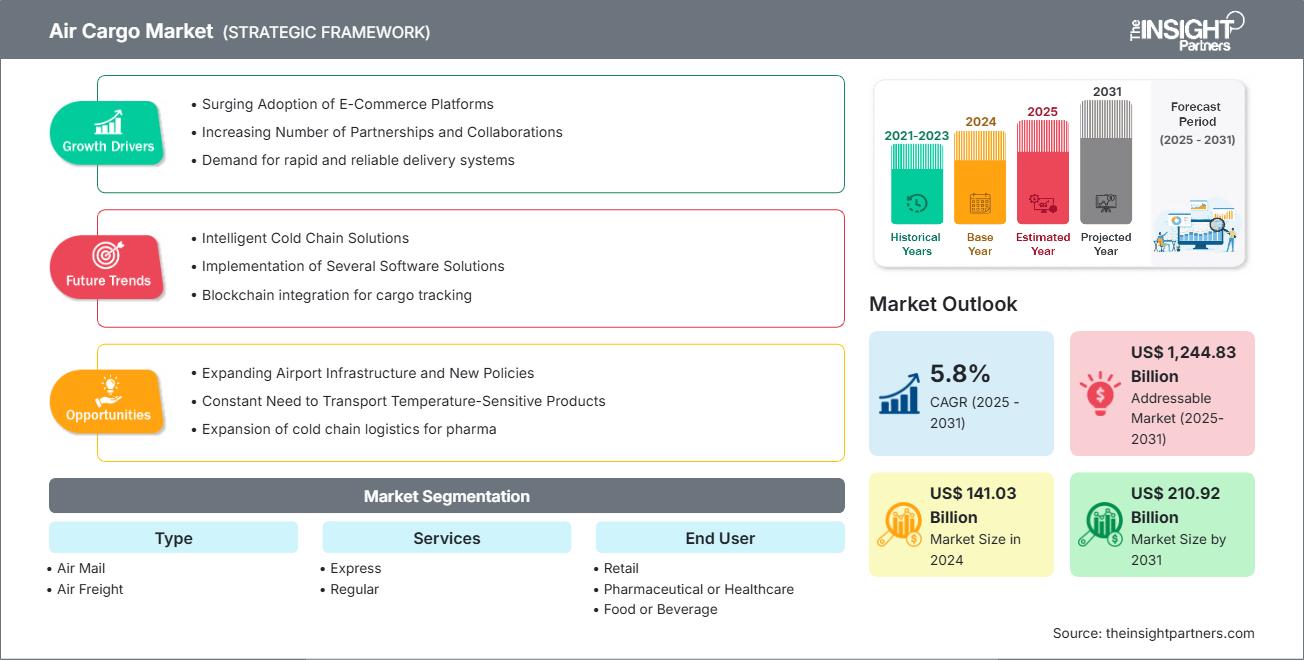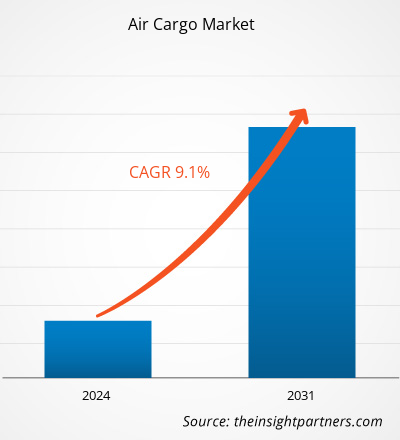Der Luftfrachtmarkt wird voraussichtlich von 141,03 Milliarden US-Dollar im Jahr 2024 auf 210,92 Milliarden US-Dollar im Jahr 2031 anwachsen. Für den Markt wird zwischen 2025 und 2031 eine durchschnittliche jährliche Wachstumsrate (CAGR) von 5,8 % erwartet.
Analyse des Luftfrachtmarktes
Der Luftfrachtmarkt wächst rasant. Die steigende Nachfrage der Endverbraucher resultiert aus veränderten Verbraucherpräferenzen, technologischem Fortschritt und einem stärkeren Bewusstsein für die Produktvorteile. Mit der steigenden Nachfrage erweitern Unternehmen ihr Angebot, entwickeln Innovationen, um den Bedürfnissen der Verbraucher gerecht zu werden, und nutzen neue Trends, was das Marktwachstum weiter ankurbelt.
Luftfrachtmarkt Übersicht
Luftfracht ist ein Transportmittel für schnelle Sendungen per Flugzeug. Sie trägt zur wirtschaftlichen Entwicklung bei, indem sie den Transport wertvoller und hochwertiger Produkte zu Verbrauchern weltweit verbessert. In der Luftfrachtbranche wurden mehrere Fortschritte beobachtet. Innovative Logistik- und Lieferkettenkonzepte, die auf niedrigen Treibstoff- und Arbeitskosten basieren, erwiesen sich als wichtige Trends für die termingerechte Produktion und die Endmontage. Darüber hinaus ist mit der abnehmenden Haltbarkeit neuer Produkte, wie beispielsweise Unterhaltungselektronik, ein Anstieg der Nachfrage nach schnellem Versand, Kontrolle und Transparenz zu verzeichnen.
Sie erhalten kostenlos Anpassungen an jedem Bericht, einschließlich Teilen dieses Berichts oder einer Analyse auf Länderebene, eines Excel-Datenpakets sowie tolle Angebote und Rabatte für Start-ups und Universitäten.
Luftfrachtmarkt: Strategische Einblicke

-
Holen Sie sich die wichtigsten Markttrends aus diesem Bericht.Dieses KOSTENLOSE Beispiel umfasst Datenanalysen, die von Markttrends bis hin zu Schätzungen und Prognosen reichen.
Treiber und Chancen des Luftfrachtmarktes
Markttreiber:
-
Steigende Akzeptanz von E-Commerce-Plattformen:
Der Online-Handel zieht aufgrund seiner weltweiten Verfügbarkeit ein größeres Publikum an als stationäre Geschäfte. Darüber hinaus nutzen E-Commerce-Marktteilnehmer Logistikoptionen wie Land- und Lufttransport, um Pakete an ihre Kunden auszuliefern. Mit dem Wachstum des globalen E-Commerce-Marktes sind unterschiedliche Kaufmuster und Trends zu beobachten. -
Zunehmende Anzahl von Partnerschaften und Kooperationen:
Im Jahr 2024 unterzeichnete IndiGo CarGo eine umfassende Interline-Vereinbarung mit Air France KLM Martinair Cargo. Ziel dieser Partnerschaft ist es, die Liefergenauigkeit und -effizienz in den gemeinsamen Netzwerken zu verbessern, die Reichweite von IndiGo zu erweitern und die Frachtdienste zwischen Indien und Europa zu verbessern.
Marktchancen:
-
Flughafeninfrastruktur und neue Richtlinien:
Luftfrachtunternehmen bieten sich in südostasiatischen Ländern wie Singapur, Thailand und Indonesien enorme Chancen. Die Flughäfen in diesen Ländern zählen zu den am schnellsten wachsenden der Welt. Turkish Cargo baut seine Präsenz mit der Einführung neuer Frachtdienste aus.
Segmentierungsanalyse des Luftfrachtmarktberichts
Der Luftfrachtmarkt ist in verschiedene Segmente unterteilt, um ein detaillierteres Verständnis seiner Geschäftstätigkeit, Wachstumschancen und neuen Trends zu ermöglichen. Nachfolgend finden Sie den Standardsegmentierungsansatz, der in den meisten Branchenberichten verwendet wird:
Nach Typ:
-
Luftpost:
Aufgrund des beschleunigten Wachstums des grenzüberschreitenden E-Commerce und des steigenden Bedarfs an schneller und zuverlässiger Zustellung kleiner Pakete und Dokumente erlebte das Luftpostsegment im Jahr 2024 eine Wiederbelebung. -
Luftfracht:
Luftfracht ist der Transport von Gütern durch ein Luftfahrtunternehmen, das kommerziell oder gechartert sein kann. Mit der steigenden Nachfrage nach schneller Lieferung steigt auch die Nachfrage nach Expressversand.
Nach Diensten:
-
Regelmäßiger Service:
Reguläre Luftfracht umfasst allgemeine Frachtdienste für weniger zeitkritische und sperrigere Sendungen. Dieses Segment hält im Jahr 2024 den größten Anteil am weltweiten Luftfrachtmarkt. -
Express-Service:
Die Express-Luftfracht hat sich im Jahr 2024 zum am schnellsten wachsenden und dynamischsten Segment auf dem globalen Luftfrachtmarkt entwickelt. Dies wird durch den unaufhaltsamen Aufstieg des E-Commerce, die steigenden Erwartungen der Verbraucher an eine Lieferung am selben oder nächsten Tag und die zunehmende Verbreitung von Just-in-Time-Lieferkettenmodellen in allen Branchen untermauert.
Durch Endbenutzer:
- Pharmazeutika
- Einzelhandel
- Speisen und Getränke
- Unterhaltungselektronik
- Sonstige
Jede Branche hat spezifische Anforderungen an die Luftfracht. Dies führt zu einem unermüdlichen Fokus auf Geschwindigkeit, Komfort und Nachhaltigkeit.
Nach Geografie:
- Nordamerika
- Europa
- Asien-Pazifik
- Süd- und Mittelamerika
- Naher Osten und Afrika
Der Luftfrachtmarkt im Asien-Pazifik-Raum dürfte das schnellste Wachstum verzeichnen. Dieses Wachstum wird vor allem durch den expandierenden grenzüberschreitenden E-Commerce-Sektor vorangetrieben.
Regionale Einblicke in den Luftfrachtmarkt
Die Analysten von The Insight Partners haben die regionalen Trends und Faktoren, die den Luftfrachtmarkt im Prognosezeitraum beeinflussen, ausführlich erläutert. In diesem Abschnitt werden auch die Marktsegmente und die geografische Lage in Nordamerika, Europa, Asien-Pazifik, dem Nahen Osten und Afrika sowie Süd- und Mittelamerika erörtert.
Umfang des Luftfrachtmarktberichts
| Berichtsattribut | Details |
|---|---|
| Marktgröße im Jahr 2024 | 141,03 Milliarden US-Dollar |
| Marktgröße bis 2031 | 210,92 Milliarden US-Dollar |
| Globale CAGR (2025 – 2031) | 5,8 % |
| Historische Daten | 2021–2023 |
| Prognosezeitraum | 2025–2031 |
| Abgedeckte Segmente |
Nach Typ
|
| Abgedeckte Regionen und Länder |
Nordamerika
|
| Marktführer und wichtige Unternehmensprofile |
|
Dichte der Akteure im Luftfrachtmarkt: Auswirkungen auf die Geschäftsdynamik
Der Luftfrachtmarkt wächst rasant. Die steigende Nachfrage der Endverbraucher ist auf Faktoren wie veränderte Verbraucherpräferenzen, technologische Fortschritte und ein stärkeres Bewusstsein für die Produktvorteile zurückzuführen. Mit der steigenden Nachfrage erweitern Unternehmen ihr Angebot, entwickeln Innovationen, um den Bedürfnissen der Verbraucher gerecht zu werden, und nutzen neue Trends, was das Marktwachstum weiter ankurbelt.

- Verschaffen Sie sich einen Überblick über die wichtigsten Akteure auf dem Luftfrachtmarkt
Analyse der Marktanteile der Luftfracht nach geografischen Gesichtspunkten
Der asiatisch-pazifische Raum dürfte in den nächsten Jahren am stärksten wachsen. Auch die Schwellenmärkte in Süd- und Mittelamerika, dem Nahen Osten und Afrika bieten Luftfrachtanbietern zahlreiche ungenutzte Expansionsmöglichkeiten.
Der Luftfrachtmarkt wächst in jeder Region unterschiedlich. Dies ist auf Faktoren wie den Aufstieg der E-Commerce-Branche und den wachsenden Handel zwischen verschiedenen Ländern zurückzuführen. Nachfolgend finden Sie eine Übersicht über Marktanteile und Trends nach Regionen:
1. Nordamerika
-
Marktanteil:
Besitzt einen bedeutenden Anteil am Weltmarkt -
Haupttreiber:
- Das Wachstum des E-Commerce treibt die Nachfrage nach schnellem und flexiblem Versand voran.
- Hightech- und Pharmaexporte erfordern zeitkritische Transporte.
- Starke Infrastruktur und große Frachtknotenpunkte (z. B. Memphis, Anchorage).
-
Trends:
Erweiterung der dedizierten Frachtflotten von Passagierfluggesellschaften zur Diversifizierung der Einnahmequellen.
2. Europa
-
Marktanteil:
Wesentlicher Anteil durch frühzeitige, strenge EU-Regulierungen -
Haupttreiber:
- Innereuropäische Handels- und Fertigungslieferketten.
- Steigende Nachfrage nach Express- und verderblicher Güterlogistik.
- EU-Nachhaltigkeitsinitiativen drängen auf eine effiziente multimodale Logistik.
-
Trends:
Einführung umweltfreundlicher Luftfrachtlösungen und SAF (nachhaltiger Flugkraftstoff) zur Emissionsreduzierung.
3. Asien-Pazifik
-
Marktanteil:
Am schnellsten wachsende Region mit dominantem Marktanteil -
Haupttreiber:
- Massive E-Commerce-Exporte aus China, Südkorea und Japan.
- Starke Abhängigkeiten von der Fertigungs- und Halbleiterlieferkette.
- Strategische Luftfrachtkorridore zwischen Asien, Nordamerika und Europa.
-
Trends:
Aufstieg grenzüberschreitender E-Commerce-Logistikplattformen und digitaler Speditionen.
4. Süd- und Mittelamerika
-
Marktanteil:
Obwohl klein, wächst es schnell -
Haupttreiber:
- Export verderblicher Waren wie Obst, Blumen und Meeresfrüchte.
- Der wachsende Konsum der Mittelschicht erhöht die Nachfrage nach Importen.
- Investitionen in Flughafen- und Kühlketteninfrastruktur.
-
Trends:
Umstellung auf regionale Frachtkonsolidierungszentren, um die Konnektivität zu verbessern und die Kosten zu senken.
5. Naher Osten und Afrika
-
Marktanteil:
Wachsender Markt mit stetigem Fortschritt -
Haupttreiber:
- Strategische Lage als Umschlagplatz zwischen den Kontinenten.
- Investitionen nationaler Fluggesellschaften in Frachtflotten (z. B. Emirates SkyCargo, Qatar Airways Cargo).
- Öl, medizinische Versorgung und Elektronik tragen zum Luftfrachtvolumen bei.
-
Trends:
Entwicklung integrierter Logistikstädte und Freihandelszonen in der Nähe großer Flughäfen (z. B. Dubai South, Kigali Logistics Platform).
Dichte der Akteure im Luftfrachtmarkt: Auswirkungen auf die Geschäftsdynamik verstehen
Hohe Marktdichte und Wettbewerb
Aufgrund der Präsenz etablierter Anbieter wie FedEx Express, UPS Airlines und DHL Aviation ist der Wettbewerb stark. Regionale und Nischenanbieter wie Emirates (VAE) und British Airways (UK) tragen ebenfalls zum Wettbewerbsumfeld in verschiedenen Regionen bei.
Dieser hohe Wettbewerbsdruck zwingt Unternehmen dazu, sich durch folgende Angebote von der Masse abzuheben:
- Investitionen in Frachtflotten
- Investitionen in die Kühlketteninfrastruktur.
Chancen und strategische Schritte
- Implementierung von KI, IoT und Blockchain für Echtzeit-Tracking, Routenoptimierung und Bedarfsprognose.
- Digitale Frachtplattformen verändern die Beziehungen zwischen Spediteuren und Frachtführern.
Die wichtigsten auf dem Luftfrachtmarkt tätigen Unternehmen sind:
- FedEx Express. (USA)
- UPS Airlines (USA)
- DHL Aviation. (Deutschland)
- Emirates SkyCargo (Dubai)
- Cathay Pacific Airways Cargo (China)
- Korean Air Cargo (Südkorea)
- Lufthansa Cargo (Deutschland)
- Singapore Airlines Cargo (Singapur)
- China Airlines Cargo.
- British Airways World Cargo (Großbritannien)
Haftungsausschluss: Die oben aufgeführten Unternehmen sind nicht in einer bestimmten Reihenfolge aufgeführt.
Weitere im Rahmen der Untersuchung analysierte Unternehmen:
- Qatar Airways Cargo
- Türkische Fracht
- Etihad Cargo
- Äthiopische Fracht- und Logistikdienste
- Saudi Cargo (Saudia Cargo)
- Asiana Cargo
- Air France KLM Martinair Cargo
- AirBridgeCargo Airlines
- MASkargo (Malaysia Airlines Cargo)
- Nippon Cargo Airlines (NCA)
- Silk Way West Airlines
- LATAM Cargo
- Avianca Cargo
- Aerologisch
- Kalitta Air
Neuigkeiten und aktuelle Entwicklungen auf dem Luftfrachtmarkt
-
SpiceXpress ist eine Partnerschaft mit Star Air aus Bengaluru eingegangen
SpiceXpress kooperiert mit Star Air aus Bengaluru, um die Frachtkapazitäten in der Flotte von Star Air zu verwalten. Durch diese Zusammenarbeit wurden neun neue Ziele in das Inlandsnetz von SpiceXpress aufgenommen, was die Tür-zu-Tür-Lieferung und die Luftfrachtinfrastruktur insbesondere in unterversorgten Regionen Indiens stärkt. -
Saudia Cargo unterzeichnete zwei wichtige globale Logistikpartnerschaftsverträge
Saudia Cargo hat zwei wichtige globale Logistikpartnerschaften unterzeichnet – eine mit dem dänischen Unternehmen Scan Global Logistics (SGL) und eine weitere mit der Air Logistics Group. Die Partnerschaft mit SGL bietet vorrangigen Zugang zum globalen Netzwerk von Saudia Cargo, während die Vereinbarung mit der Air Logistics Group integrierte Luftfrachtlösungen zwischen Großbritannien und Saudi-Arabien verbessert.
Bericht zum Luftfrachtmarkt: Umfang und Ergebnisse
Der Bericht „Größe und Prognose des Luftfrachtmarkts (2021–2031)“ bietet eine detaillierte Analyse des Marktes, die die folgenden Bereiche abdeckt:
- Größe und Prognose des Luftfrachtmarktes auf globaler, regionaler und Länderebene für alle wichtigen Marktsegmente, die im Rahmen des Berichts abgedeckt sind
- Trends im Luftfrachtmarkt sowie Marktdynamiken wie Treiber, Beschränkungen und wichtige Chancen
- Detaillierte PEST- und SWOT-Analyse
- Analyse des Luftfrachtmarkts mit wichtigen Markttrends, globalen und regionalen Rahmenbedingungen, wichtigen Akteuren, Vorschriften und aktuellen Marktentwicklungen
- Branchenlandschaft und Wettbewerbsanalyse mit Marktkonzentration, Heatmap-Analyse, prominenten Akteuren und jüngsten Entwicklungen für den Luftfrachtmarkt
- Detaillierte Firmenprofile
- Historische Analyse (2 Jahre), Basisjahr, Prognose (7 Jahre) mit CAGR
- PEST- und SWOT-Analyse
- Marktgröße Wert/Volumen – Global, Regional, Land
- Branchen- und Wettbewerbslandschaft
- Excel-Datensatz
Aktuelle Berichte
Erfahrungsberichte
Grund zum Kauf
- Fundierte Entscheidungsfindung
- Marktdynamik verstehen
- Wettbewerbsanalyse
- Kundeneinblicke
- Marktprognosen
- Risikominimierung
- Strategische Planung
- Investitionsbegründung
- Identifizierung neuer Märkte
- Verbesserung von Marketingstrategien
- Steigerung der Betriebseffizienz
- Anpassung an regulatorische Trends






















 Kostenlose Probe anfordern für - Luftfrachtmarkt
Kostenlose Probe anfordern für - Luftfrachtmarkt